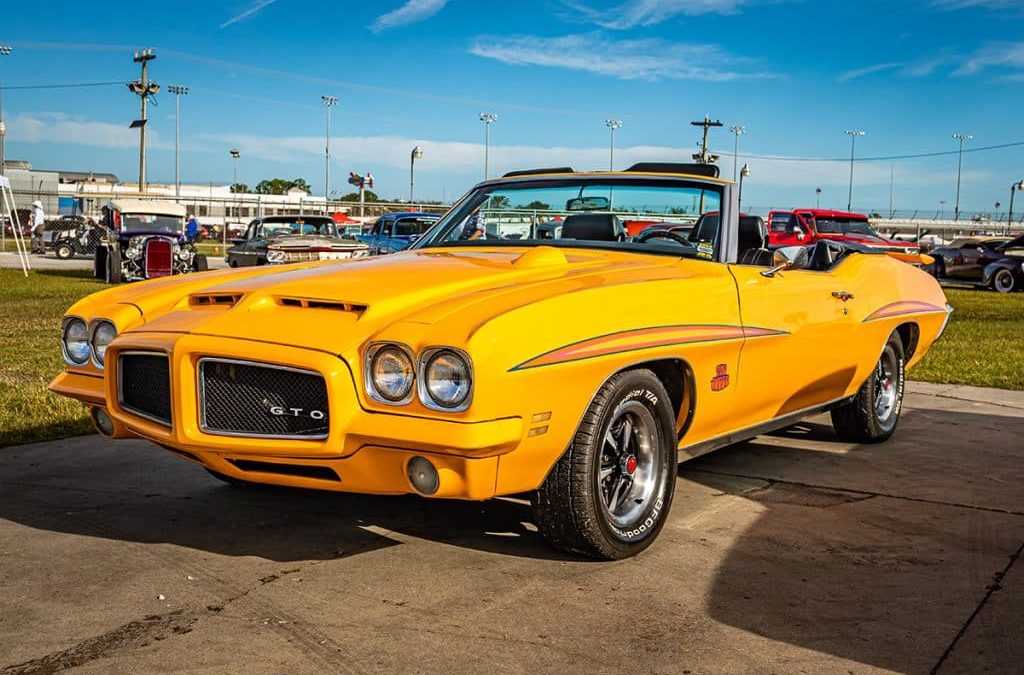
Daytona Beach, FL – November 27, 2020: 1971 Pontiac GTO “The Judge” convertible at a local car show.
Paint jobs can be one of the most expensive parts when restoring a classic car or truck. It is also one of the hardest things to protect from damage.
There are the obvious things you need to avoid like UV rays from the sun that can fade the paint. Driving down gravel roads that can chip your paint should be an obvious thing to avoid.
There are, however, things that can damage your classic car’s paint that you might not expect. Even if it seems farfetched that these items will come into contact with your car’s surface, it is still good to know what to look out for.
Here is a list of things that can surprisingly damage a vehicle’s paint.
Brake Fluid
Not all brake fluid will damage paint, but you need to use caution if you happen to spill any on your classic. If the brake fluid is not silicone-based (typically older brake fluid), it can be caustic and act like a paint thinner which can be very destructive to your paint’s surface. Fortunately, modern-day paints have been developed to withstand contact with harsh chemicals like this.
Bird Droppings
It is inevitable. At some point a bird will certainly fly over your classic and drop their deposit on your ride. Whether your classic is at the car show, cruising the strip or just sitting in the driveway, bird droppings are a part of life. We truly suspect that birds seek out shiny things to aim for, but it is just a theory.
Aside from a mess to clean up, bird droppings can be quite acidic and can quickly begin to deteriorate paint. If left out in the sun to dry, the droppings can harden and really start to do some damage.
Use caution when removing these flying fertilizers. It can often contain remnants of nuts and seeds that can scratch the paint. It is certainly best to remove it before it has a chance to dry, but if it does, it is definitely a good idea to allow soap and water or some other cleaner to soak before washing it off.
Insects
Bugs, like birds, are another unavoidable thing that can damage your paint. Bugs that strike your classic will often leave behind all their inner juices which is also highly acidic.
Striking an insect while driving is unlikely to scratch or chip your paint. It is when they are left to dry that they become dangerous. It is certainly a must to clean and remove them from the paint as soon as possible. Like bird droppings, it is a good idea to let them soak before trying to remove them.
Tree Sap
We can’t imagine you would park your classic car or truck under a tree for many reasons. Besides bird droppings or falling branches, pinecones, etc., there is also the likelihood of tree sap landing on your vehicle.
Getting this stuff off your paint can be dreadful. Wipe it while it is still fresh and it tends to smear, making the problem area bigger. If you wait for it to dry, it comes hard as a rock. We think it is best to get to cleaning as soon as possible. There are cleaners specifically made for tree sap, but plain rubbing alcohol will do the trick. Just make sure to put a good coat of wax after cleaning the area as rubbing alcohol can remove wax too.
Gasoline
Take care when fueling up at the station. Gas that overflows or drips onto your paint can stain and damage the clearcoat. The best way to avoid this damage is to have a good coat of wax on your classic and wash off any gasoline that comes in contact with your vehicle’s surface.
Tar
During the hot summer months, tar can melt and make a serious mess on your classic if driven through. Fresh asphalt can also be a messy culprit that can sling tar. It isn’t so much damaging as it is a pain to remove. You will likely need a specialty cleaner to remove it. Here is a video from a car detailer that shows multiple ways to remove tar without damaging the paint.
Acid Rain
Hopefully, your classic car or truck is stored inside out of the rain and other weather elements. Nonetheless, did you know that acid rain can eat away at your vehicle’s paint? When acid rain is allowed to collect on your car, it will eventually evaporate leaving an acidic material behind. This material can eat away at your paint, causing damage that can be hard to reverse.
If for some reason this has happened, it may take a special cleaning to remove it. We suggest you use clay bars to remove these stains and grime from the paint. They are quite simple to use. Just wet down the paint and lightly rub the clay back and forth. Finish cleaning the area with a microfiber towel and repeat as necessary.
Fingerprints
It never fails. You spend hours getting your classic to shine like a diamond only to have someone accidentally put their oily hands on your car or truck. It happens at car shows all the time. Spectators may inadvertently touch the car as they lean in for a closer look.
Fingerprints and other body oils will collect dust and dirt which can harm the topcoat. While it is not the end of the world if it happens, it still is a good idea to remove it as soon as possible.
Dirty Rags
Last but certainly not least, many people make the mistake of using dirty rags and towels on the exterior of their car.
Whenever using a towel on your car, make sure it’s clean and don’t set it on the ground in between uses. Not only is this unsanitary, but the towel can pick up dirt and tiny particles that can scratch the surface of your car. While you might not notice at first, these scratches can accumulate over time and become more noticeable.
Also, while a towel might feel soft to the touch, it doesn’t mean it’s right for the surface of your car. Always be sure to use a microfiber washcloth or towel and clean it often. The last thing you want to do when trying to take care of your car is damage it!
There are other things that can damage your cars paint like Silly String, shaving cream, ashes, and shoe polish for example, but we have a hard time imagining a scenario where these items will be able to touch your car.
Please consider subscribing to our monthly email newsletter to keep up with everything that’s going on at the Wilson Auto Repair garage. Also, follow us on Instagram, @carmechanic, and sign up for a LIVE, one-on-one Zoom consultation with Barry Wilson, our master mechanic to discuss any challenges you might be facing with your classic vehicle repair or restoration project. Finally, visit Wilson Auto.com, to find the tools we use and recommend to you for your classic car project.

